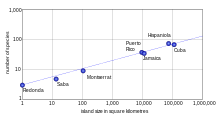Species-area relationship
The species-area relationship , also species number-area relationship or species-area relationship , is the relationship between the size of areas and the number of species living there . Most of the time, the number of species decreases as the area becomes smaller (area effect ). The graphical representation of the number of species depending on the surface area is known as type-area curve or species area curve .
Typical is an initially steep art area curve, which then becomes increasingly flatter. Suitable logarithmic representations of art-area curves are often approximately a straight line - the relationship between the two quantities can therefore be described by a power function . In equation form, with species number S, area A and constants c and z <1, usually:

Species-area relationships are usually investigated for a group of organisms. The consideration of the relationship across different, isolated island-like areas (oceanic islands, sky islands , fragmented forest islands, clearings, areas with different soil types) is the subject of island biogeography . A second type of species-area relationship is the number of species as a function of the increasing size of a contiguous sample area. In this case, one speaks of a mainland species-area relationship .
The connection between island size and biodiversity can already be found in Reinhold Forster and Georg Forster's report on the second South Sea voyage (1772–1775) with James Cook :
"Islands produce only a greater or less number of species, as their circumference is more or less extensive."
"Islands produce a larger or smaller number of species solely according to their larger or smaller extent."
In the 19th century, research into the relationships between the number of species and the size of the area became an important field of research in plant ecology . Augustin-Pyrame de Candolle confirmed the observation of the Forsters in 1820, but also saw influences from the isolation, age, climate and volcanism of islands. In 1859, Hewett Watson found that small sample areas already contained nearly half of all species in Britain. The first Art Areal curve is also attributed to him. In the 1920s, Olof Arrhenius, son of the well-known Swedish physicist Svante Arrhenius , and Henry Allan Gleason formulated mathematical models. Influential work by FW Preston and by Robert H. MacArthur and Edward O. Wilson in the 1960s extended the investigation to include the fauna. MacArthur and Wilson explained the number of species on islands as a balance between extinction and immigration, with larger islands hosting a greater number of species in equilibrium.
A large number of explanations are given for the exact form of species-area relationships, including the number of habitat types (habitat diversity), which often correlates with the size of the area, the remoteness of island-like habitats, properties of the group of organisms under consideration, such as their ability to migrate , or the Type of sampling.
Species-area relationships are the subject of investigation in macroecology and biogeography . They serve to identify, explain and compare patterns, extrapolate species numbers and estimate species losses. In nature conservation biology they are used in questions of species protection , in paleontology in explaining past extinction events .
Web links
- Species-Area Relationships. Oxford Bibliographies.
Individual evidence
- ↑ species-area relationship. In: Spectrum Lexicon of Biology. Spektrum Akademischer Verlag, accessed on November 18, 2017 .
- ↑ Matthias Schaefer: Areal effect . In: Dictionary of Ecology . Springer, 2012, ISBN 978-3-8274-2562-1 .
- ↑ Art area curve. In: Spectrum Lexicon of Geography. Spektrum Akademischer Verlag, accessed on November 18, 2017 .
- ↑ a b c Even Tjørve and Kathleen MC Tjørve: species-area relationship . In: Encyclopedia of Life Sciences (eLS) . 2017, doi : 10.1002 / 9780470015902.a0026330 .
- ^ Johann Reinhold Forster: Observations made during a voyage round the world . 1778, 5. Organic Bodies - 1. Number of Species, p. 169 ( biodiversitylibrary.org ).
- ^ A b c Samantha M. Tessel, Kyle A. Palmquist and Robert K. Peet: Species-Area Relationships . In: Oxford Bibliographies . April 28, 2016, doi : 10.1093 / obo / 9780199830060-0147 .
- ↑ Olof Arrhenius: Species and Area . In: Journal of Ecology . tape 9 , no. 1 , September 1921, doi : 10.2307 / 2255763 ( britishecologicalsociety.org [PDF; 421 kB ]).
- ^ Henry Allan Gleason: On the Relation Between Species and Area . In: Ecology . tape 3 , no. April 2 , 1922, doi : 10.2307 / 1929150 .
- ↑ Mark V. Lomolino: The species-area relationship: new challenges for an old pattern . In: Progress in Physical Geography . tape 25 , no. 1 , March 2001, p. 1-5 , doi : 10.1177 / 030913330102500101 .
- ↑ FW Preston: The Canonical distribution of commonness and Rarity: Part I . In: Ecology . tape 43 , no. 2 , April 1962, doi : 10.2307 / 1931976 ( ubc.ca [PDF; 3.1 MB ]).
- ^ Robert H. MacArthur and Edward O. Wilson: An Equilibrium Theory of Insular Zoogeography . In: evolution . December 1963, doi : 10.1111 / j.1558-5646.1963.tb03295.x . Further developed in: Robert H. MacArthur and Edward O. Wilson: The Theory of Island Biogeography . 1967.
- ↑ Michael Begon , Colin R. Townsend, and John L. Harper : Ecology - Individuals, Populations, and Communities . Birkhäuser - Springer, 2013, ISBN 978-3-0348-6156-4 , chapter "Islands, areas and settlement".
- ↑ Norman MacLeod: Types dying - turning points of evolution . Theiss Verlag - Wissenschaftliche Buchgesellschaft Darmstadt, 2016, ISBN 978-3-8062-3284-4 .

